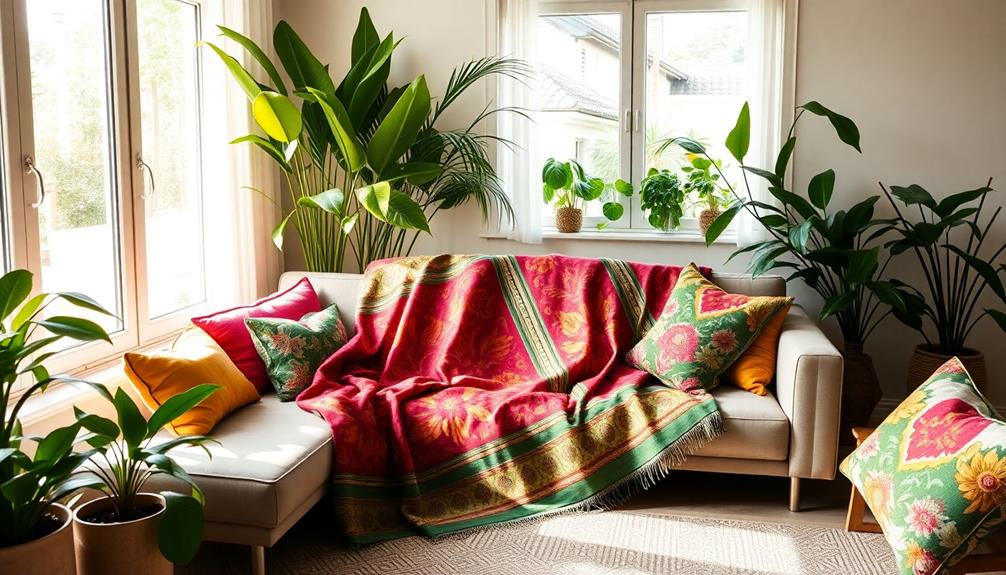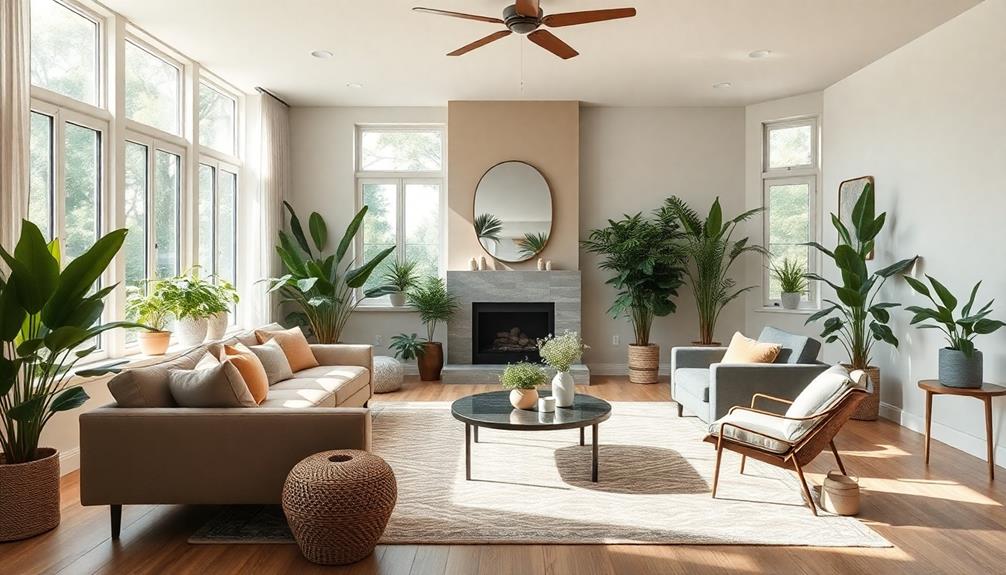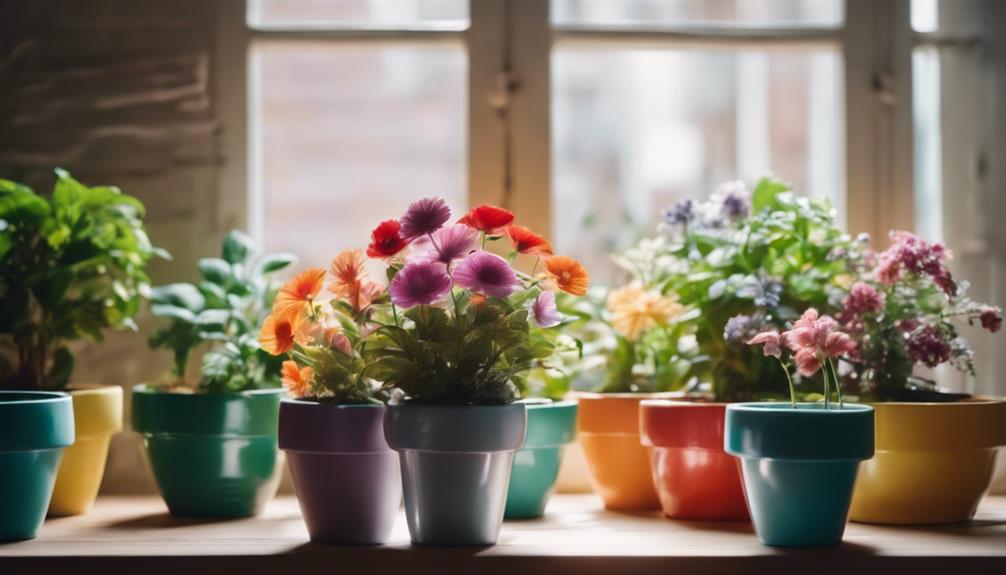Indonesian textiles are the stunning game-changer your interior design needs. With over 6,000 unique designs, these textiles reflect rich cultural stories through techniques like ikat and batik. They infuse your space with vibrant colors sourced from natural dyes, creating an authentic aesthetic. Not only do they add beauty, but they also preserve cultural heritage while supporting local artisans. By incorporating these textiles, you bring a layer of meaning and identity into your home. Plus, you'll discover how contemporary designs can blend perfectly with timeless Indonesian artistry, showcasing a unique style that's hard to ignore. Curious to find out more?
Key Takeaways
- Indonesian textiles, particularly ikat and batik, offer vibrant colors and intricate designs that elevate modern interior aesthetics.
- Each textile embodies rich cultural narratives, adding depth and storytelling to interior spaces.
- Sustainable practices in producing these textiles appeal to environmentally-conscious consumers and designers.
- Collaborations between contemporary designers and traditional artisans revitalize interest and support local craftsmanship.
- Utilizing natural dyes enhances the authenticity and unique appeal of Indonesian textiles in interior design.
Cultural Significance of Indonesian Textiles

In the vibrant tapestry of Indonesian culture, textiles like ikat hold profound significance that goes beyond mere aesthetics. You'll discover that each of the over 6,000 distinct designs represents the rich heritage of Indonesia's 17,000 islands. These patterns often encapsulate local myths, flora, and fauna, serving as storytelling mediums that embody spiritual beliefs rooted in pre-Islamic animism.
Additionally, much like the unique artistic expressions found in Indonesian decor masks, these textiles aren't just functional but also serve as important cultural artifacts.
The cultural significance of Indonesian textiles extends into social structures, too. They play vital roles in traditional ceremonies and rituals, symbolizing status and identity within communities. Imagine attending a marriage ceremony where these textiles are exchanged as gifts, marking not just a union but the weaving of families and traditions.
Moreover, the intricate dyeing and weaving techniques employed in creating these textiles highlight the craftsmanship and artistic value each piece carries. As modernization creeps in, preserving these textile traditions becomes essential for maintaining cultural identity.
Unique Techniques and Materials

When you explore Indonesian textiles, you'll discover traditional weaving techniques like ikat and batik that showcase incredible skill.
These methods often utilize natural dyes from local plants, giving each piece its vibrant colors and eco-friendly appeal.
Additionally, incorporating handcrafted items like vibrant Indonesian decorative pillows can enhance your living space while reflecting cultural heritage.
Traditional Weaving Techniques
Traditional weaving techniques in Indonesia showcase a rich tapestry of cultural heritage, with methods like ikat, batik, and songket each telling a unique story.
When you explore ikat, you'll find it involves a complex dyeing technique where threads are dyed before weaving. This allows artisans to create intricate patterns that often symbolize natural elements or sacred themes, making every piece a reflection of its surroundings. Additionally, the vibrant artistry of these textiles reflects the rich Indonesian culture, much like the traditional artistry of Indonesian decor masks, enhancing the overall aesthetic appeal of any space.
Batik, on the other hand, utilizes a wax-resist dyeing process. Here, wax is applied to fabric before dyeing, resulting in stunning designs that narrate stories rooted in Indonesian culture. You can see the vibrancy and detail in each batik piece, which speaks volumes about the region it comes from.
Lastly, songket is a luxurious weaving technique that incorporates gold and silver threads, traditionally reserved for ceremonial garments. With elaborate motifs, songket reflects the status of the wearer and adds a touch of elegance to any interior.
Natural Dye Sources
Combining the artistry of traditional weaving techniques with the vibrant hues of natural dyes brings Indonesian textiles to life.
You'll discover that these textiles often utilize natural dye sources from local plants, minerals, and insects, ensuring both stunning colors and environmental sustainability. For instance, indigo creates deep blues, turmeric yields bright yellows, and the roots of the sappan tree produce rich reds.
This showcases Indonesia's incredible biodiversity and expertise in dyeing practices, much like the intricate designs found in Indonesian decor masks, which also reflect local culture and folklore.
The dyeing process isn't just straightforward—some colors require intricate methods, with the red dye process involving as many as 56 steps to achieve the perfect hue.
Each region in Indonesia boasts its own unique dyeing techniques, often utilizing fermented materials or specific plant parts, reflecting the cultural significance tied to textile creation.
Historical Context and Evolution

How have Indonesian textiles evolved over the centuries to reflect the country's rich cultural tapestry? The historical context of these textiles reveals a fascinating journey shaped by trade routes and cultural exchanges, particularly from Chinese and Indian influences.
Traditional Indonesian housing styles, such as Rumah Adat, also reflect regional identities that are mirrored in the textiles produced in those areas.
- Ikat, Batik, and Songket: Each technique showcases unique regional characteristics and traditional practices.
- Symbolism and Storytelling: Patterns often narrate local myths, flora, and fauna, preserving cultural expression.
- Ceremonial Significance: Textiles serve as symbols of status and identity across various communities.
From the ceremonial to the everyday, textiles have played crucial roles in Indonesian life.
They've symbolized social standing and cultural identity, adapting through generations while maintaining their roots.
The documentation of their evolution reflects a blend of indigenous techniques and modern adaptations, emphasizing the ongoing relevance of these textiles in today's global fashion landscape.
As you explore Indonesian textiles, you'll find a rich historical context that not only highlights their beauty but also deepens your appreciation for the stories they tell.
Embracing this evolution allows you to incorporate these vibrant pieces into your interior design, celebrating both tradition and contemporary style.
Contemporary Applications in Design

Indonesian textiles, with their vibrant colors and intricate patterns, are making a significant mark in contemporary interior design. You'll notice that designers are increasingly integrating these textiles, particularly ikat and batik, into modern spaces. This trend adds cultural depth and a unique charm that captures the eye.
Luxury tropical designs often feature these textiles, showcasing their ability to elevate the aesthetic of interior spaces. By using handwoven textiles in upholstery and drapery, you can bring in unique textures and natural dyes that reflect the rich heritage of Indonesian craftsmanship.
The minimalist design philosophy prevalent today pairs seamlessly with the bold aesthetics of Indonesian textiles. This balance promotes relaxation and tranquility in your home.
Plus, sustainable practices in textile production are becoming essential for environmentally-conscious designers like you. By choosing textiles that utilize natural dyes and support local artisans, you're making a positive impact.
Collaborative projects between contemporary designers and traditional weavers are also revitalizing interest in Indonesian textiles. This fusion leads to fresh interpretations that resonate with modern sensibilities while preserving the cultural significance of these beautiful fabrics.
The Role of Ikat in Interiors
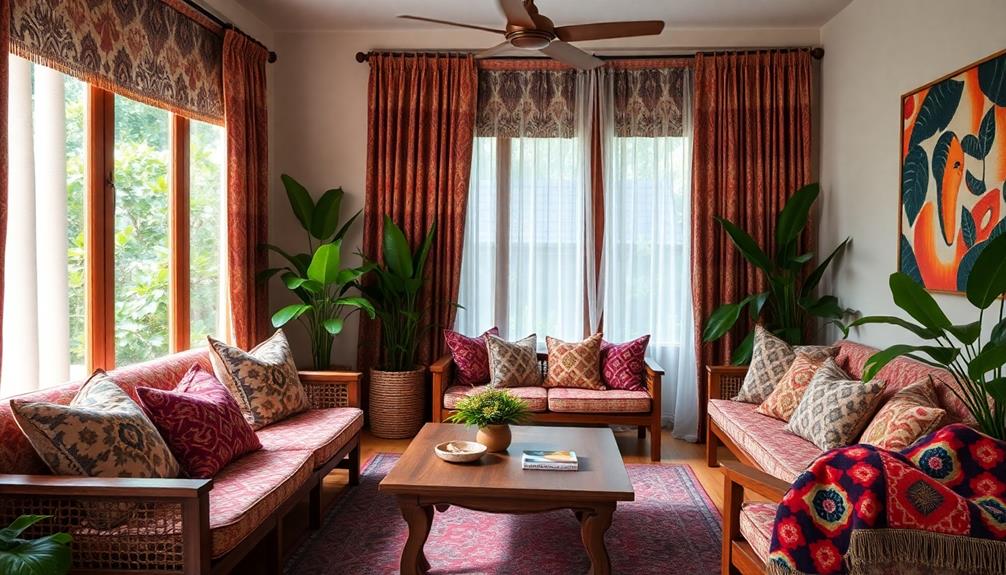
Amidst the diverse world of interior design, ikat textiles stand out with their striking patterns and rich cultural narratives. Unique to Indonesia, these fabrics feature over 6,000 distinct designs, making them perfect focal points in your home.
The intricate double ikat weaving technique results in outstanding natural patterns that enhance any space's aesthetic appeal. Incorporating ikat into your decor can beautifully complement the principles of Balinese design characteristics, which emphasize a connection to nature and sustainability.
- Evoke authenticity and cultural connection
- Utilize vibrant colors from natural dyes
- Versatile applications for modern schemes
Incorporating ikat into your interiors doesn't just beautify; it tells a story. Each textile often symbolizes local myths, flora, and fauna, enriching your decor with layers of meaning.
The sustainable aspect of ikat, thanks to its use of natural dyes, aligns with the growing demand for environmentally friendly materials. Whether you choose ikat for upholstery, curtains, decorative cushions, or wall hangings, it seamlessly fits into various design styles.
Economic Impact on Local Artisans

The economic landscape for local artisans creating ikat textiles is increasingly challenging. You might be surprised to learn that hand-made ikat sarongs can be purchased for less than Rp 180,000 (around US $20), yet artisans receive only a fraction of that price for their intricate work. This highlights the significant economic impact on local artisans, who struggle to maintain their livelihoods amid the rising dominance of machine-made textiles.
These mass-produced alternatives replicate traditional motifs but don't provide fair compensation to the original creators. Additionally, incorporating traditional batik patterns into your home decor not only enhances aesthetic appeal but also supports local craftsmanship as seen in Indonesian wedding decor ideas.
Moreover, traditional textiles, rich in cultural significance, are often dismissed as old-fashioned, limiting their market appeal. While the global market for ikat textiles is growing, the shift in demand can undermine the economic stability of traditional weaving communities.
Factories in East Java further dilute the authenticity of these textiles by mixing regional motifs, impacting the economic sustainability of artisans dedicated to preserving their unique cultural heritage.
As you explore the beauty of Indonesian textiles for your interior design projects, consider the essential role you play in supporting these artisans. Choosing genuine ikat pieces can help sustain their craft and enhance your space with authentic cultural richness.
Preservation Efforts for Textile Heritage
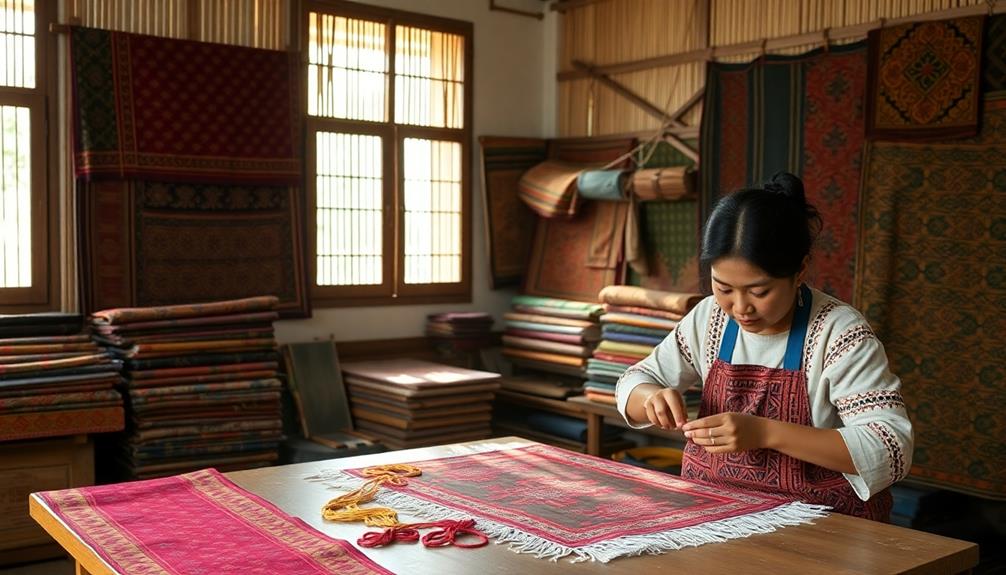
Preserving textile heritage is vital for maintaining cultural identity and supporting local artisans. Organizations like Threads of Life, established in 1998, lead significant preservation efforts by working with over 1,000 weavers across Indonesia. Their initiatives focus on:
- Promoting traditional textile production with natural dyes, which aligns with the emphasis on sustainability seen in Tropical Villa Plans.
- Documenting complex dye processes to guarantee knowledge transfer.
- Immersing younger generations in traditional crafts.
Threads of Life emphasizes sustainable practices, particularly in dye production, which conserves important plants while protecting local ecosystems. By prioritizing methods that involve leaf collection over bark harvesting, they ensure that both culture and environment thrive.
However, challenges persist. Formal education outside the community can disrupt the transmission of cultural practices. Community members play a vital role in preserving this heritage by guiding newcomers through observation and hands-on participation rather than rigid teaching methods.
Their knowledge-sharing fosters a deeper connection to tradition, guaranteeing that these invaluable skills aren't lost.
Ultimately, your support of preservation efforts helps secure the future of Indonesian textiles. By appreciating and incorporating these textiles into your home, you contribute to the survival of a rich cultural legacy.
Global Trends in Textile Use
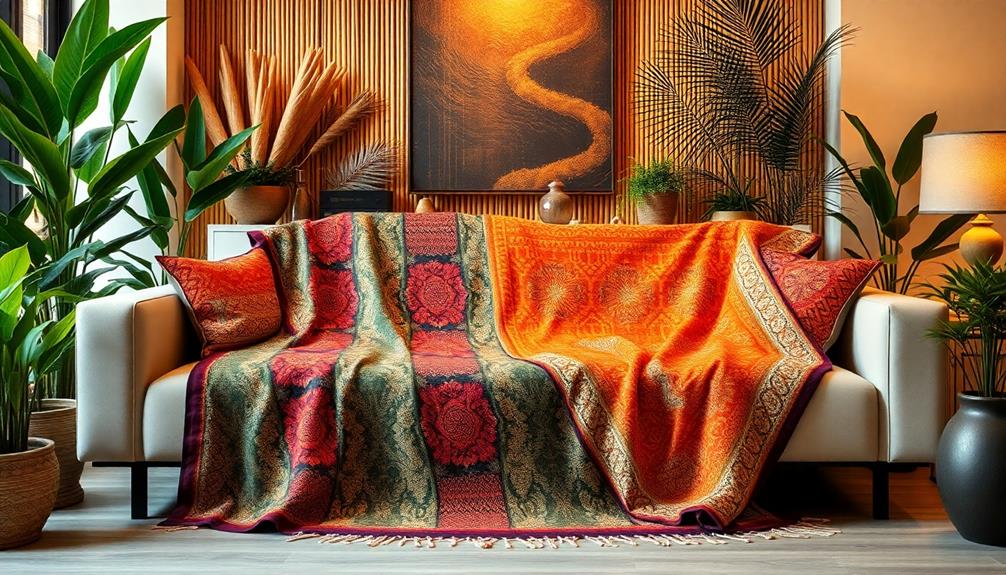
Efforts to preserve Indonesian textile heritage are increasingly relevant as global trends shift in how these textiles are used and appreciated. You might not realize that the market for traditional Indonesian textiles, especially ikat, is booming, showcasing over 6,000 unique designs. As international interest grows, local artisans struggle against machine-made alternatives that dilute authenticity.
Here's a quick comparison of key trends:
| Trend | Impact on Traditional Textiles |
|---|---|
| Increased global interest | More demand for unique designs |
| Rise of machine-made textiles | Economic disparity for artisans |
| Preference for natural dyes | Concerns over sustainability |
| Modernization of traditional designs | Broader appeal in fashion |
While handmade ikat sarongs can be found for under Rp 180,000 (approx. US $20), artisans often receive only a fraction of that price. This disparity highlights the need for conscious consumer choices. You would know that embracing authentic textiles not only supports artisans but also preserves Indonesia's rich cultural legacy. Balancing modern trends with traditional craftsmanship is essential for sustaining this unique heritage.
Frequently Asked Questions
What Is the Indonesian Textile Technique?
Imagine wrapping yourself in a tapestry of history. Indonesian textile techniques like ikat, batik, and songket, each tell a story through vibrant colors and intricate patterns, showcasing artistry and cultural heritage. You'll appreciate their beauty.
What Are the Traditional Indonesian Textiles?
Traditional Indonesian textiles include ikat, batik, and songket. Each technique showcases unique patterns and cultural significance. You'll appreciate their intricate designs, vibrant colors, and sustainable materials that reflect Indonesia's rich heritage and craftsmanship.
What Is the Fabric Design in Indonesia?
"Beauty's in the eye of the beholder." In Indonesia, fabric designs like ikat, batik, and songket showcase vibrant patterns and rich cultural stories. Each piece connects you to heritage, nature, and community through unique craftsmanship.
How Big Is the Textile Industry in Indonesia?
The textile industry in Indonesia's massive, valued at around USD 20 billion in 2022. With about 1.5 million people employed, it plays a vital role in the economy while showcasing rich cultural heritage through traditional textiles.
Conclusion
Incorporating Indonesian textiles into your interior design isn't just a trend; it's a way to weave stories of culture and craftsmanship into your spaces. These vibrant fabrics add a layer of depth, transforming rooms like a painter's brush brings life to a canvas. By embracing these textiles, you're not only elevating your home but also supporting local artisans and preserving a rich heritage. So go ahead, let these unique pieces speak their colorful tales throughout your interiors.

